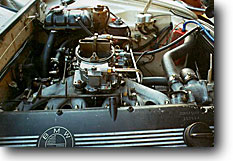Euro versions of the 6 and 7 series come with a
Solex 4a 4bbl on a BMW manifold. It bolts right up to the head in
place of the two for the 2 x 2bbls. It opens up the area under the
hood considerably and eliminates synchronizing problems.
There are a number of these that were imported by
individuals and as grey market cars. More and more of them are finding
their way to becoming donor cars for us trying to keep the E3s on
the road.
The Solex 4a that is standard OEM on the BMW big 6
- M30 engines in Europe is like the Zeniths that came on the E3s
and, just like them, make great door stops, paper weights, etc..
The 4a throttle plate footprint matches up with the Spreadbore footprint
of American cars and carburetor manufacturers. The match is exact
until you get to the back two mount holes. They are about a quarter
inch off of the rear Holley mounting holes.
Holley models 4165, 4175, 4011, and the 4360
"Economaster" closely fit the mounting footprint on the BMW manifold.
Also the Rochester, Quadrajet, the new Edelbrock carbs (read here
"expensive" and "Weber knock off"), Carters, and the ThermalQuad
have the same footprint.
|
|
| 1 |
|
No manifold modifications.
Use a spreadbore carb and rattail file out the 2 back mount
holes into slots until they fit. Works fine, but voids the warranty
on new carbs. |
| 2 |
|
Serious manifold modifications. Have the
two back mount holes (or right holes since the carb sits sideways
compared to American engines) on the manifold welded up and
add extra material, machined flat, redrilled and taped. Cost
about $100 or more and it needs to be bolted up to an old head
during the welding to prevent warping |
| 3 |
|
No manifold modifications. Use an adapter
plate to adapt from spreadbore to square flange, there are
some on the market only about 1/4" - 1/2" thick. You would
need to redrill and counter sink the back mounting holes on
the adapter, like the back mounting holes on the carbs mentioned
above, but it will allow you to use the carb you have without
modifying the carb. The additional volume under the carb should
actually help. I haven't tried this method yet. Some of the
thicker adapters may cause problems with room between the
top of the carburetor / air cleaner and the hood.
Number 3 will be my next experiment. The spreadbore pattern
carbs are only available in 650 cfm or larger only, except
for the Economaster at 450 cfm. The square flange will allow
me to use smaller cfm carbs for better low end torque. That
is what I'm am going to do on the Polaris Bavaria in the garage
in the near future.
And for all you folks in CA, when the OEM air cleaner is
on the carb, it effectively blocks all visual inspection
and looks dead stock, just like the OEM air cleaner on the
Webers.
Some Carburetors have the accelerator pump on the top rather
than the side like Webers or bottom, and causes clearance
problems with the bottom of the OEM air cleaner. A small
space will take care of that problem and is relatively inexpensive.
And you should be able to find CARB approved replacement
carbs at your local auto store.
|
| |
|
The stock linkage found on the manifolds originally
works great. Using parts of the linkage from the Zeniths
and a small length of 6 mm threaded rod, it is easy to make
the link from the linkage on the manifold to the carburetor.
|
| Now
on to the carbs. |
| 1 |
|
Economaster, 450 CFM, electric choke, mechanical
secondaries, Spreadbore foot print. Great power on the low
end, but it had a serious bog when the secondaries open (accelerator
pump on the primaries only, not secondaries), except when it
was on my 728 auto, no bog(?), just real smooth. Probably be
able to dial the out bog with float adjustments, etc.. All parts
and gaskets available at parts stores, but no jets are available
(according to the guys at Stupid Shops). I don't think that
you can buy them new any more (maybe some one out there can
help), they are about $100 +, used, in fair shape, more if rebuilt
- and there are a lot of used ones out there. |
| 2 |
|
The next one I tried was a List # 9895, 650
CFM, electric choke, vacuum secondaries., a direct replacement
for the 350 cid Corvette stock carburetor. Ran like a SLUG.
I tried everything to dial it in, changed jetting, power valves,
meter plates, float levels, fuel line pressures, on and on and
on..... |
| 3 |
|
Changed to the Model 4165, 650 CFM, electric
choke, vacuum secondaries. Ran fairly good up to about
32-3300 RPM then seem to starve from there. One day, at 6000
the secondaries opened and threw me back in the seat. Bought
a secondary diaphragm spring kit and used the lightest spring,
secondaries opened at 4500, best I could get (changed carbs
before really trying hard to dial it in - changed due to another
unrelated problem). You could feel and hear the secondaries
kicking in, it felt and sounded great! Remember, this carburetor
is also made for a 350 cid GM. |
| 4 |
|
My latest carburetor is a 4011.
650 CFM, electric choke, with mechanical secondaries, double
pumper. The extra accelerator pump on the secondaries takes
care of any bog when they open. Smooth from low to high RPM,
no torque on the low end, but runs fantastic at high RPM and
sometimes runs past red line quick if I don't catch it. It needs
to be dialed in to get better power on the low end, I know it
needs better jetting. I will hold off doing that until I get
the new 3.5L engine in, sometime in the real near future. No
sense in doing it twice. |
For those in CA the idea of changing to a 4bbl with one
of the many "approved replacement carburetors" on the market
for American cars, may be worth looking into.
|
|

